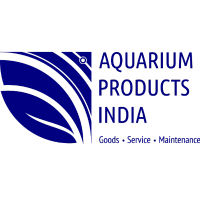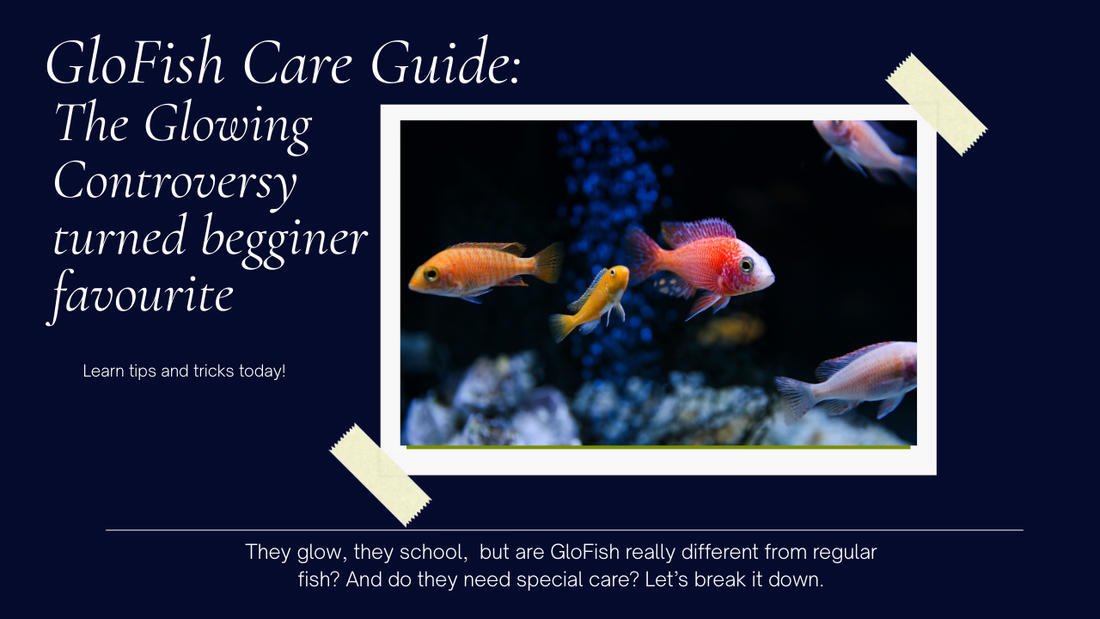GloFish Care Guide – The Glowing Controversy Turned Beginner Favorite
They glow, they school, and they start conversations — but are GloFish really different from regular fish? And do they need special care? Let’s break it down.
🧬What Are GloFish, and Where Did They Come From?
GloFish are genetically modified aquarium fish, originally developed in the early 2000s for scientific purposes , particularly to detect environmental pollution. Scientists inserted bioluminescent genes from jellyfish and coral into fish embryos, resulting in vibrant fluorescence under blue/black light.
They were later commercialized for the pet trade, first in the US, and now globally.
✅ GloFish are NOT dyed or painted — their glow is permanent, heritable, and 100% safe
⚠️ In India, GloFish may be regulated or restricted in some areas (always verify legality with your local fisheries department)
🎨 Which Fish Species Are GloFish?
GloFish aren't a species - they’re color-enhanced versions of common beginner fish:

|
GloFish Type |
Original Species |
Size |
Behavior |
|
GloFish Danio |
Danio rerio (Zebra Danio) |
2" |
Fast, peaceful |
|
GloFish Tetra |
Gymnocorymbus ternetzi (Black Skirt Tetra) |
2" |
Peaceful, mid-level |
|
GloFish Barb |
Puntius tetrazona (Tiger Barb) |
2.5" |
Semi-aggressive |
|
GloFish Betta |
Betta splendens |
2.5–3" |
Territorial, solo fish |
|
GloFish Shark |
Epalzeorhynchos frenatum (Rainbow Shark) |
5–6" |
Aggressive, bottom-dweller |
Each one glows in electric colors like Starfire Red, Electric Green, Galactic Purple, Cosmic Blue, and Sunburst Orange.
🌿 Natural Habitat & Feeding in the Wild
Since GloFish are lab-modified, they don't exist in the wild . But, their base species come from tropical rivers and streams across Asia and South America.
Their wild ancestors:
- Feed on insects, algae, detritus
- Prefer clean, oxygen-rich water
- Are hardy and highly adaptable
🏠 Tank Size & Setup

|
Species |
Min Tank Size |
Ideal Setup |
|
Danio, Tetra |
10–20 gallons |
School of 6+, planted tank |
|
Barb |
30 gallons |
Group of 5–6, open swimming space |
|
Betta |
5–10 gallons (solo) |
Gentle filter, soft lighting |
|
Shark |
55+ gallons |
Plenty of hiding spots, low competition |
GloFish are best kept in species-specific groups unless you're experienced with tank dynamics.
💧 Ideal Water Parameters
|
Parameter |
Range |
|
Temperature |
22–28°C (72–82°F) |
|
pH |
6.5–7.5 |
|
Hardness |
5–15 dGH |
|
Ammonia/Nitrite |
0 ppm |
|
Nitrate |
< 20 ppm |
✅ Stable temperature is key for GloFish color and immunity
✅ Use Life AAYU Bacter Boost Plus for healthy cycling and Nutro Fit Plus to enhance immune response, especially in GloBetta and GloShark
🧠 Behavior & Personality
- Danios and Tetras: Schooling, fast, fun
- Barbs: Nippy if not in a group — must be kept in 5+ numbers
- Bettas: Solo, interactive with owners
- Sharks: Territorial; need lots of room and hiding spaces
GloFish don’t behave differently than their normal versions - but lighting and tank color can influence their activity levels.
🌊Lighting, Décor & Tank Tips
- Use blue LED or GloFish-specific lighting to enhance fluorescence
- Dark substrate and backgrounds make colors pop
- Live or silk plants offer shelter
- Avoid bright white light as it can wash out the glow
Glow looks best under low ambient room light + actinic tank light.
⏳ Lifespan & Growth
|
Species |
Average Lifespan |
|
Danios, Tetras |
3–5 years |
|
Bettas |
2–4 years |
|
Sharks |
5–8 years (longer if housed alone) |
GloFish grow at the same rate as their regular counterparts and are generally not stunted or weaker, contrary to some myths.
👨👩👧👦Tank Mates
✅ Good companions:
- Mollies, Platies, Swordtails
- Corydoras, Otocinclus
- Other GloFish of same species
- Rasboras, Guppies (non-barb tanks)
❌ Avoid:
- Angelfish (may eat GloDanios)
- Fin-nipping mixes (Barbs + Bettas)
- Large cichlids, aggressive sharks
🧫 Common Health Issues
GloFish are hardy, but poor care leads to:
- Ich during temperature drops
- Fin rot in GloBettas due to dirty water
- Color fading from poor nutrition or lighting
✅ Use Life AAYU Nutro Fit Plus weekly to enhance color, boost immunity, and prevent internal infections
✅ Change 30% water weekly, avoid ammonia spikes
🍽️ Best Food for GloFish
✅ Natural Color Enhancement – Beta carotene, astaxanthin, and paprika extract boost vibrant red, blue, and yellow tones.
✅ Spirulina & Omega 3 Blend – Supports immunity, growth, and fish activity.
✅ Clean Water Formula – Handmade and digestion-friendly to reduce waste and clouding.
✅ Soft Floating Pellets – Easy to feed and loved by glowfish, tetras, guppies, and danios.
✅ Multi-Vitamin Fortified – Improves resistance to stress, enhances fin and scale health.
✅ Safe for All Ornamental Fish – Suitable for both freshwater and low-salinity tanks.
🟢 Feed 1–2 times a day — small portions only
🔴 Overfeeding = color fading and ammonia buildup
♀️♂️ How to Tell Male from Female GloFish
|
Species |
Male |
Female |
|
Danio |
Slim, brighter |
Rounder belly |
|
Tetra |
Smaller |
Deeper body |
|
Betta |
Longer fins |
Shorter, rounder |
|
Barb |
More active |
Larger, slightly duller |
Note: Fluorescent genes don’t affect sex or reproductive organs.
🐣 Can You Breed GloFish?

Breeding GloFish is:
- Technically possible, but ethically and legally restricted in many regions
- Offspring carry the glow gene if both parents are GloFish
- You may need permits in some areas (like the US or EU)
- In India, selling or reproducing genetically modified fish may be restricted
Always check local legal guidelines. Commercial breeding of GloFish is patented and controlled by license.
🎨 Why Do GloFish Glow?
- GloFish glow due to GFP (green fluorescent protein) or RFP (red fluorescent protein) inserted into their DNA
- These proteins react to actinic (blue) or UV light, making them fluoresce
- The glow is not visible in total darkness some light is required
💡 Bonus Tips & Common Myths
- GloFish do not require special food but color-enhancing food helps
- They are not dyed or injected … glow is natural and safe
- They don’t glow in total dark a light source is essential
- Great for kids, beginner aquarists, and educational tanks
📩Need Expert Help?
💬 Write to us at info@mayurdevaquascaper.com
📍 Visit our Gallery in Mumbai (GSM Aquarium Products)
🛒 Shop high-quality Indian-made food and supplements: AquariumProductsIndia.in





